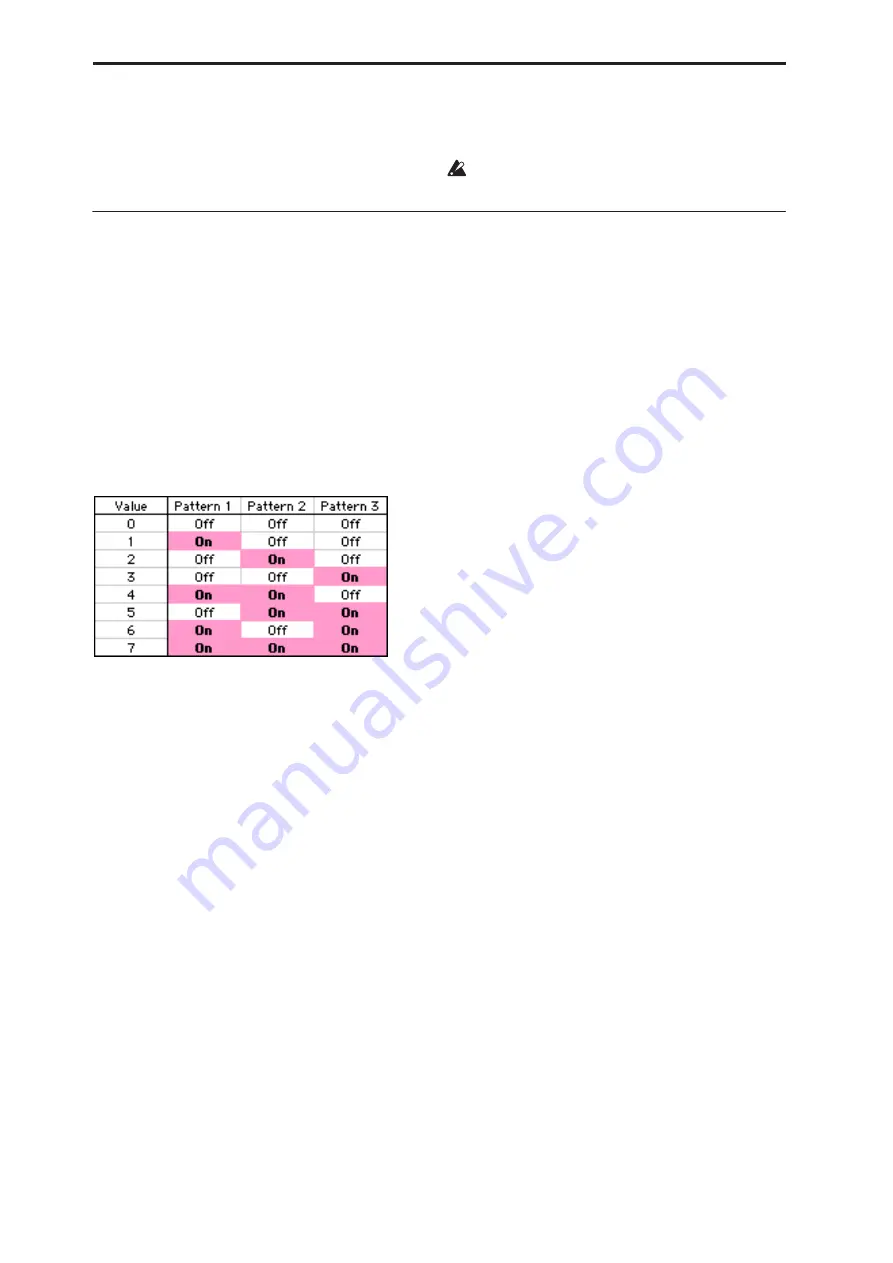
KARMA GE guide
950
Also shown above is a 65th column, known as the
“Always Column” and indicated by the abbreviation
“a” underneath it. When a row is selected in this
column, it will cause any values in that row of the
Drum Pattern to always be played, regardless of any
randomization that is going on, or regardless of the
“Poly/Pools” setting (discussed later on).
Pattern grids cannot be viewed or edited on the
OASYS.
Associated Parameters
Play On/Off
[0, 1]
When
1: On
, the Drum Pattern is played during Note
Generation. When
0: Off
, the Grid may contain values
but will not be played during Note Generation. This
can be used to temporarily “mute” one or more
patterns during playback.
On/Off Combinations
[0…7]
Controls all 3 Drum Pattern On/Off at the same time,
in various combinations. The values
0–7
select one of 8
different combinations, shown in the following table:
Row1…7 Note
[0…127]
Selects a Drum Sound/MIDI Note Number for each of
the 7 rows of the selected Drum pattern.
Row1…7 Vel. Offset
[–127…+127]
Allows the velocity for notes from that row only to be
offset with regards to other rows. For example, you can
use this to make a snare softer overall than a kick. Note
that this is subtractive/additive: “0” leaves velocities
at the Initial Velocity they would normally be
generated with based on the Velocity Group settings.
So setting positive amounts may interfere with the
Velocity control that you have specified elsewhere. One
example is controlling the velocity sensitivity of the
Drum Pattern with the keyboard. Regardless of your
Velocity Group settings, if the Row Velocity Offset here
was a large positive value, you would get no apparent
velocity sensitivity from the keyboard for this row,
since this value would be added and effectively cancel
out the effects of the Velocity Mode and Value.
Rhythm Multiplier
[1…800 (%)]
Multiplies the current Rhythm Pattern. Note that this is
entirely independent of the same parameter in the
Rhythm Group. This means that each Drum Pattern
can have a different “Rhythm Multiplier.” (
For example, if you set the Rhythm Pattern to 32nds,
you could drive one Drum Pattern with a “Rhythm
Multiplier” of
100%
at 32nd note speed, and another
Drum Pattern at
200%
for 16th note speed. If they were
the same number of steps, it would take twice as long
to perform the entire 16th-based pattern as the 32nd-
based pattern. This also means that the Rhythm
Pattern driving the underlying Riff (that may be
applied as Pitch Bend or used to randomize the Drum
Patterns) can be operating at a different rhythmic
relationship. For example, if the Rhythm Pattern was
set to 16ths, and the Drum Pattern “Rhythm
Multiplier” to
50%
, the Drum Pattern would be
generated as 32nd-based, while any arpeggiated pitch
bend would be 16th-note based, or 1 bend every 2
steps of the Drum Pattern.
[0…5]
Selects from a quantized set of “straight” values for the
“Rhythm Multiplier” field of the associated Drum
Pattern(s). In other words, when applied to a Rhythm
pattern containing values such as 16th notes, the
resulting rhythmic values will be straight values such
as 8th notes, quarter notes, etc.
[0…10]
Selects from a quantized set of “straight & triplet”
values for the “Rhythm Multiplier” field of the
associated Drum Pattern(s). In other words, when
applied to a Rhythm pattern containing values such as
16th notes, the resulting rhythmic values will be
straight values such as 8th notes, quarter notes, etc. or
various triplet values.
[0…15]
Selects from a quantized set of “straight, triplet &
dotted” values for the “Rhythm Multiplier” field of the
associated Drum Pattern(s). In other words, when
applied to a Rhythm pattern containing values such as
16th notes, the resulting rhythmic values will be
straight values such as 8th notes, quarter notes, etc.,
various triplet values, or various dotted values.
0: Off
1: On
0…127: C–1…G9
0: 25%
2: 100%
4: 200%
1: 50%
3: 200%
5: 800%
0: 25%
3: 68%
6: 200%
9: 544%
1: 34%
4: 100%
7: 272%
10: 800%
2: 50%
5: 136%
8: 400%
0: 25%
4: 68%
8: 150%
12: 400%
1: 34%
5: 75%
9: 200%
13: 544%
2: 37%
6: 100%
10: 272%
14: 600%
3: 50%
7: 136%
11: 300%
15: 800%
Summary of Contents for Electronic Keyboard
Page 1: ...Parameter Guide Parameter Guide ...
Page 2: ......
Page 180: ...Program mode EXi 170 ...
Page 290: ...EXi STR 1 Plucked String 280 ...
Page 572: ...Sequencer mode 562 ...
Page 700: ...Global mode 690 ...
Page 751: ...Insert Effects IFX1 IFX12 Routing 741 Fig 2 3a Fig 2 3b ...
Page 902: ...Effect Guide 892 ...
















































